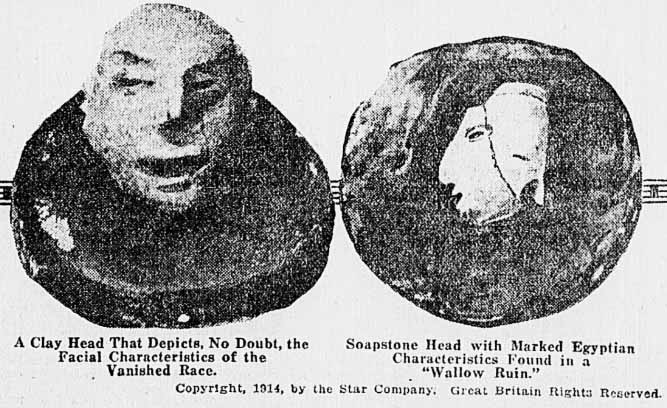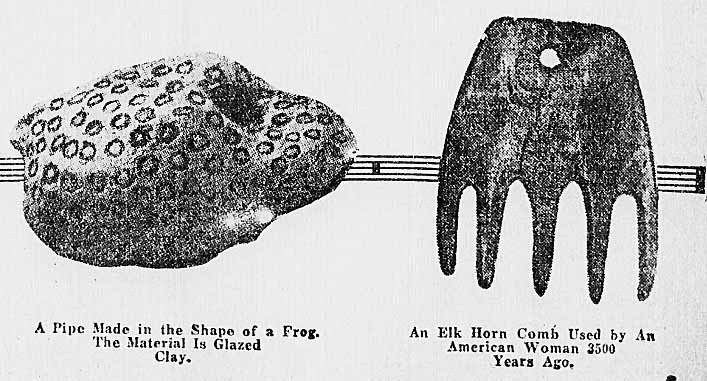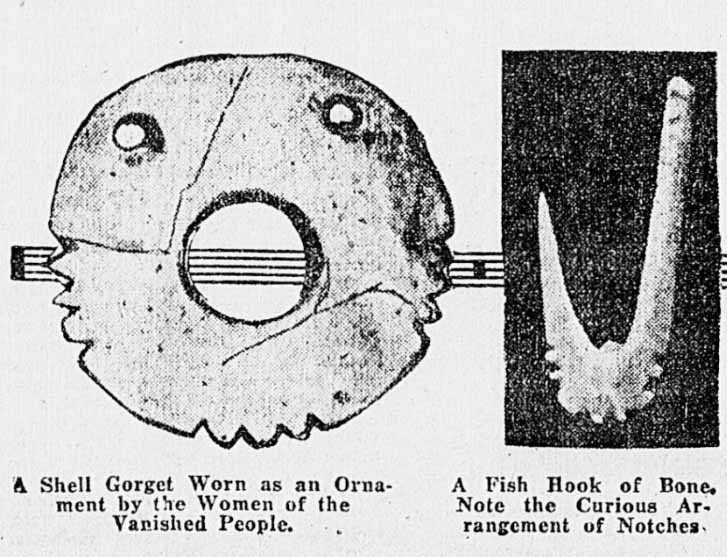
The following article, published in 1914, talks about the discovery of underground homes in Nebraska and what was found inside the “wallows.”
What was most fascinating about this find were the Egyptian or Aztec looking artifacts in the American prairies, as shown below.

Americans Who Lived in Underground Prairie Homes 3,500 Years Ago
Professor Robert W. Gilder, archaeologist for the University of Nebraska, has made the curious discovery that the familiar “buffalo wallows” of the West were never made by buffaloes. They are, instead, the ruins of underground dwellings in which thousands of years ago lived a race which vanished over thousands of years ago.
The “wallows” were thought to be what their name indicates even by the Indians, thus proving that the red men themselves knew nothing of the race that made the dens.
The modern Indians were just as much surprised as the whites when they discovered what Professor Gilder was taking out of the old indentations. The archaeologist would point to one of the wallows and then tell his little audience just what he would find in it. This he was enabled to do by reason of the curious similarity in the arrangement of and the things found in the dens. The Indians were appalled, however, by what they thought was his uncanny insight, and now they call him “Man-Who-Sees-Through-the-Ground.”

This curious people were skilled in the art of making pottery and in turning out realistic heads and figurines in clay and stone. All their underground houses and caves were built in the shape of squares. These rectangles, oddly enough, do not square like many primeval dwellings, with the points of the compass, but with the North Star, which is a few degrees off due north. The majority of the caves have their entrances at the south, and some have inclines fifty feet long leading down to the door.
This mysterious people dwelt by millions on the prairies. Professor Gilder has uncovered near the west bank of the Missouri River, near Omaha, what appears to have been a metropolis of the race. Ethnologists who have examined the relics have found no resemblance with either the pre-Columbian Indians or with the mound builders.
There is no clue to indicate who these people were or how they were wiped out. Nor is it clear what conditions forced a whole race to live in burrows beneath the ground.
However, among the ruins of the long-filled burrows, Professor Gilder has found a little carved head of pink soapstone.
The little pink head is Egyptian in every feature. It is delicately carved and highly polished. It is Egyptian in headdress, having even the rectangular ear guard worn by the Egyptians. It is more than Egyptian. It resembles the face of Rameses II himself, if the marble busts in the Oriental museums today are images of the Egyptian king and the mummy unearthed in the sands of Egypt in 1881 and now reposing in the Boulak Museum at Cairo is really his corpse.
Another clay image has the pronouncedly sloping eyes peculiar to Chinese.

Geologists have furnished some assistance to the archaeologists in determining the probably age of the ruins. It takes years for black soil to accumulate where it is not washed in. This soil accumulates from decaying grasses. Darwin once made an experiment in the accretion of soil, and computed that but little over an inch collected in a hundred years.
How many centuries, then, may have gone while these two or three feet of black soil have gathered on the sunken roofs of the fallen cave homes!
At least a thousand years before Christ, say the geologists, our cavemen dropped into oblivion and their homes had begun to decay.
In uncovering something over thirty these homes, Professor Gilder has established the general character of the caves and their contents. The floor is strewn with charred sticks, reeds, coarse grasses and charred corncobs. In the floor of every cave is found a cache where most of the domestic utensils and the other valuables are hidden. It is this cache that the archaeologist always seeks. Sometimes there are several in the same cave. The mouth of the cache is always found plugged with a layer of burnt clay. On top of this is a layer of ashes. Beneath all, the cavity widens like a jug or bottle, often to the size of a hogshead.
Source: The times dispatch. (Richmond, Va.), 15 Feb. 1914.

